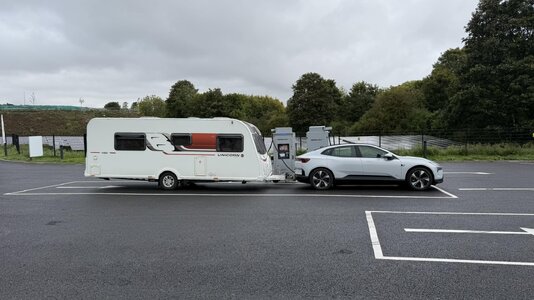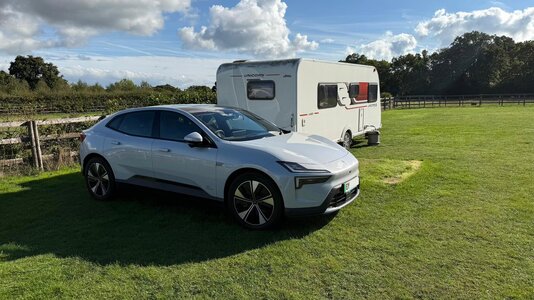- Jul 23, 2021
- 1,041
- 984
- 5,435
So we finally got to test the Polestar 4 as a tow car this week. Not a huge trip but far enough to get a good feel. Due to a mess up on my part with the home charger we left home last (South Northamptonshire) on Sunday with just 71% battery and a 115 mile run to Danebury CL near New Milton in the New Forrest. However it gave us a good opportunity to test out the chargers at Winchester on the way.
The Polestar 4 in LRDM (Long range Dual motor) spec, has a 101kWh (96kWh usable) battery, 400kW / 536 bhp motors, 686Nm / 506 lbf- ft torque with AWD. Towing limit is 2000kg with a 100kg max towball load. So lots of capacity to tow our 1550kg MTPLM Bailey Unicorn S3 Vigo.

When we got going, there had been a bit of rain over night with wet roads, and some rain persisting. It had also been cold, so the battery was chilly, and a large unit takes some time to warm up, so I wasn't expecting peak performance. Deploying the fully automatic towbar was simplicity its self, with it unfurling from the back of the car at the touch of a button in the boot, and locking into placed with a satisfactory whir. The reversing camera (while missing the centre line guide on the Polestar 2, (come on Polestar - add it over the air please), made it easy to hitch, with a distance readout on the screen in cm from the closest point.
The trailer light check offered to start automatically, but some how I messed up the activation, so a manual one ran (I did manage to get an automatic one this morning when I returned the caravan to storage). All hitched and off we went. With the caravan on hook, the car automatically disables pilot assist, Blind spot warning and the rear fog light, but does let you use the adaptive cruise control - very handy for following lorries.
With all the torque on tap, and AWD, pulling away and getting up to speed is very easy, and the weight of the car keeps the caravan under control. The adaptive dampers manage the extra weight with no problem.
Having left home at 10:30, we pulled into the Instavolt Winchester hub at 12:11, 82 miles later, at 18% battery. Winchester has 4 pull through charging stations designed specifically for towing, so by 12:13 the charge had started. We both used the facilities, and I grabbed a coffee. 30 mins later, having added 70kWh of energy (an amazing average rate of 140kW - MUCH faster than the previous car), I stopped the charge and we got going again, having increased charge level to 82%.
The remaining journey of 37miles taking us down to 62%.
Over all the journey of 115 miles used 73% of the battery or 70ish kWh of energy, for an average of 60.93 kWh per 100 miles or 1.6 miles per kWh givving a theoretical maximum range of 157 miles.

We pitched and had a great week. Danebury is a lovely CL with individual water as well as metered 16A hookup (10kWh included per night). It also has the possibility of using their 7kW car charger, though we opted not to.
Having spent a great few days, the threat of the winds arriving tonight, and the potential for a very wet day led us to come home two nights early. We had been out and about during the day, and had the car charged to 83% ready to come home. After a quick pack down, we got underway just before 5pm. This time the battery was warm (it had been 18C all day, and we had charged on a 30kW charger in Lyndhurst), and the roads were bone dry, so I was expecting much better performance. Once out of the of the forest, and back onto the M27, I set the cruise to 55mph, until a lorry passed us, when I set it to 60, and let the car follow the truck at a safe distance. While stopping again was an option, looking at the economy readout, I was confident we could get home without a stop, a journey that would not have been possible on that starting state of charge in the Polestar 2. As we carried on, the economy kept improving, until as we pulled home at 21%, the car was reading an average consumption of just 52.9 kWh / 100 miles or 1.89miles per kWh, giving a potential maximum of 181 miles towing range, an amazing performance with very good results.
The combination of very rapid sustained charging (140kWh average up to 82%) and a real range of well in excess of 150 miles with a buffer in all weathers, makes this quite a machine. It allows for 300 mile days, with just one stop of 45 mins or so, if the bladders of the driver and passenger can manage, or 400 miles with two shorter stops - far more than I would normally consider in one day myself. Perhaps the south of France with the caravan is on the cards for next year
The Polestar 4 in LRDM (Long range Dual motor) spec, has a 101kWh (96kWh usable) battery, 400kW / 536 bhp motors, 686Nm / 506 lbf- ft torque with AWD. Towing limit is 2000kg with a 100kg max towball load. So lots of capacity to tow our 1550kg MTPLM Bailey Unicorn S3 Vigo.

When we got going, there had been a bit of rain over night with wet roads, and some rain persisting. It had also been cold, so the battery was chilly, and a large unit takes some time to warm up, so I wasn't expecting peak performance. Deploying the fully automatic towbar was simplicity its self, with it unfurling from the back of the car at the touch of a button in the boot, and locking into placed with a satisfactory whir. The reversing camera (while missing the centre line guide on the Polestar 2, (come on Polestar - add it over the air please), made it easy to hitch, with a distance readout on the screen in cm from the closest point.
The trailer light check offered to start automatically, but some how I messed up the activation, so a manual one ran (I did manage to get an automatic one this morning when I returned the caravan to storage). All hitched and off we went. With the caravan on hook, the car automatically disables pilot assist, Blind spot warning and the rear fog light, but does let you use the adaptive cruise control - very handy for following lorries.
With all the torque on tap, and AWD, pulling away and getting up to speed is very easy, and the weight of the car keeps the caravan under control. The adaptive dampers manage the extra weight with no problem.
Having left home at 10:30, we pulled into the Instavolt Winchester hub at 12:11, 82 miles later, at 18% battery. Winchester has 4 pull through charging stations designed specifically for towing, so by 12:13 the charge had started. We both used the facilities, and I grabbed a coffee. 30 mins later, having added 70kWh of energy (an amazing average rate of 140kW - MUCH faster than the previous car), I stopped the charge and we got going again, having increased charge level to 82%.
The remaining journey of 37miles taking us down to 62%.
Over all the journey of 115 miles used 73% of the battery or 70ish kWh of energy, for an average of 60.93 kWh per 100 miles or 1.6 miles per kWh givving a theoretical maximum range of 157 miles.

We pitched and had a great week. Danebury is a lovely CL with individual water as well as metered 16A hookup (10kWh included per night). It also has the possibility of using their 7kW car charger, though we opted not to.
Having spent a great few days, the threat of the winds arriving tonight, and the potential for a very wet day led us to come home two nights early. We had been out and about during the day, and had the car charged to 83% ready to come home. After a quick pack down, we got underway just before 5pm. This time the battery was warm (it had been 18C all day, and we had charged on a 30kW charger in Lyndhurst), and the roads were bone dry, so I was expecting much better performance. Once out of the of the forest, and back onto the M27, I set the cruise to 55mph, until a lorry passed us, when I set it to 60, and let the car follow the truck at a safe distance. While stopping again was an option, looking at the economy readout, I was confident we could get home without a stop, a journey that would not have been possible on that starting state of charge in the Polestar 2. As we carried on, the economy kept improving, until as we pulled home at 21%, the car was reading an average consumption of just 52.9 kWh / 100 miles or 1.89miles per kWh, giving a potential maximum of 181 miles towing range, an amazing performance with very good results.
The combination of very rapid sustained charging (140kWh average up to 82%) and a real range of well in excess of 150 miles with a buffer in all weathers, makes this quite a machine. It allows for 300 mile days, with just one stop of 45 mins or so, if the bladders of the driver and passenger can manage, or 400 miles with two shorter stops - far more than I would normally consider in one day myself. Perhaps the south of France with the caravan is on the cards for next year

